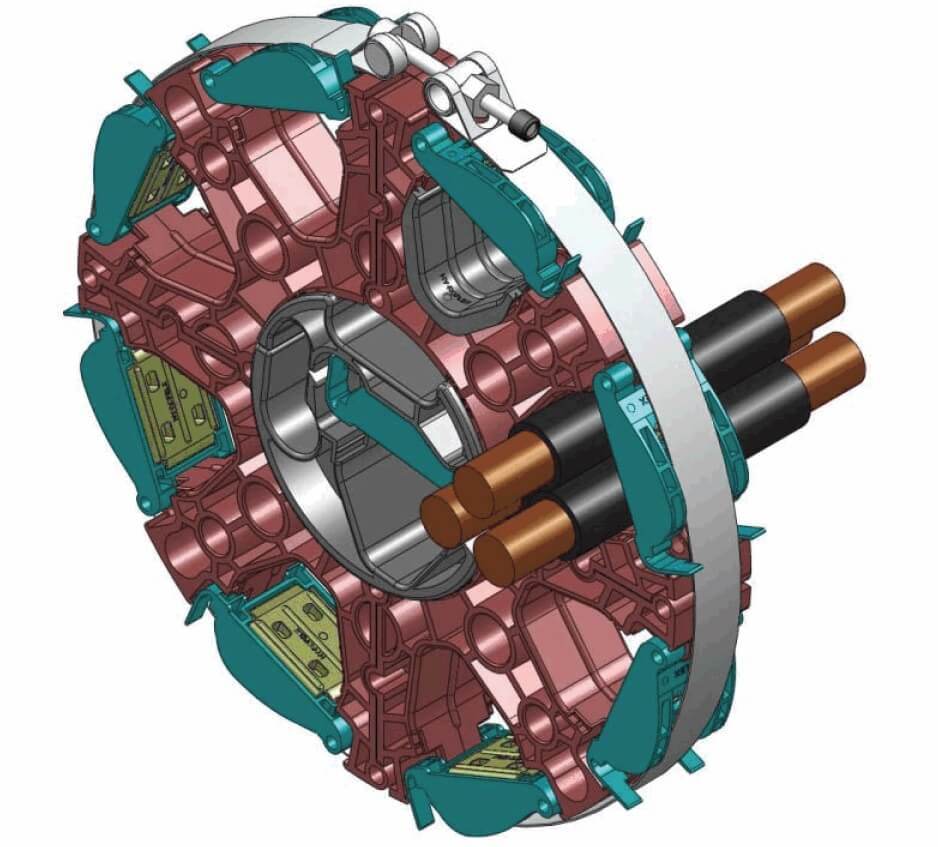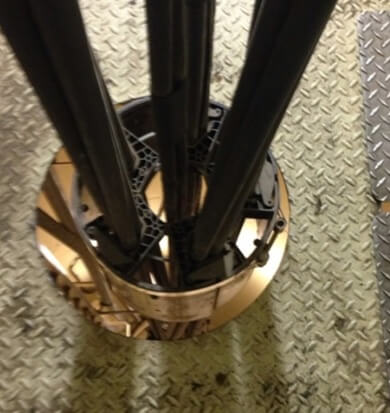
What a mess. This drip loop has made about one nacelle revolution and the yaw motors will have no trouble twisting it once more. This turbine’s owner should expect major insulation wear and eventually, exposed conductors.
The drip loop is the bundle of cables responsible for carrying all the power, data, signals, and communication for everything generated inside a nacelle. The loop is needed to provide enough slack for the turbine to yaw a few revolutions keeping it pointed into the wind.
While the cables in this loop meet wind industry standards, especially for torsion, oil resistances, and temperature, current industry practice of tightly bundling them has serious impacts.
The biggest problem with closely arranging cables in this manner is there can be as many as 16 tightly bundled together, twisting and rubbing against each other. This arrangement creates excessive heat and wears down the jacket insulation, ultimately exposing a cable conductor which can carry between 600 to 1,000V.
This wear can appear only a few months after the start of operations but is often missed or overlooked during end-of-warranty inspections or when competing with other major corrective action. It’s no

The CAD model of one SOHL unit show several triangular openings for up to three power cables. Smaller data cables are secured in other passages.
surprise that the abrasion issue can eventually lead to turbine faults and downtime, and in worst cases, serious injury to technicians. “Over the past 15 years, I have visited many wind farms with trash containers filled with worn cables that had been cut out of the drip loop,” says Jim Moorman, Wind Industry Manager at Lapp USA, a global cable manufacturer.
Three wind-industry specialists have recognized the problem and joined forces to deliver a device that solves the premature cable wear issue along with expert installation. The companies, System One Services, Hydac, and Lapp USA, collaborated on the design of the SOHL, a turnkey cable-management system, able to address the issue of drip loop cable tear.

In a working turbine, SOHL organized cables look like this. The shroud below the organizer protects cables from abrasion with the steel floor. Cables are secured by plastic separators and then by the steel band clamp on the outer circumference. The cables in the drip loop will need several of the units.
Moorman, also the SOHL program spokesman, describes the device as a multi-function, engineered cable gland, and management system for drip loop applications. “But it’s really a disc, informally called the snowflake star clamp, less than one meter in diameter with several modular clamps that each secures one to three cables,” he adds.
These issues are coming back right from the field. “Our team has worked side by side with technicians up-tower trying to resolve power cable issues whether it is dangerously exposed conductors, knots in the conductor, abrasion damage, or jacket damage relating to poor cable management,” says Moorman
There are home-grown solutions, but they often just exacerbated the problem. “For instance, 12 to 15 zip ties on a drip loop make the cables look organized, but it doesn’t take a lot of thought to zip tie things together. Anything tightly clamped or choking the cables will begin embedding into the jacket and insulation creating thin or weak spots,” he says.
Current bundling practices also prevent proper heat dissipation of the cables so they run hotter at the drip loop than intended, accelerating their life especially at weak spots in the jacket. “Insulation tapes work OK patching stationary cables. But in the drip loop, it is a band-aid. Significant wear continues and the cable will need attention and possible replacement later,” he says.
The compact modular design of the device allows for proper heat dissipation to keep the cables cool for maximum efficiency. “Diameter compensation is built-in so industry-approved high-performance cables maintain their integrity and durability. The SOHL turnkey program includes kitted electrical cable-management components and expert installation. The SOHL turnkey cable management system can guarantee to pay off in reduced downtime alone. It’s a tested and proven system that eliminates cable wear and replacement costs,” he says.
In addition, Systems One Services provides install know-how. “It takes about half a day to install on existing cables and a full day if the cables are being replaced,” said Moorman. The number of snowflake glands and the install method is turbine specific. Therefore, an installation by cable connection experts ensures easy cable maintenance, replacement, and safer working conditions for technicians.
Filed Under: Cables & connectors, News, O&M





